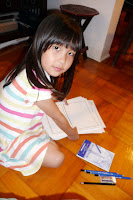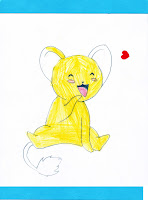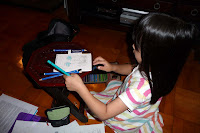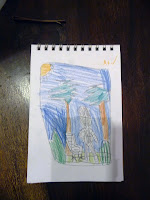
It had been a while since I had the opportunity to do a cartoon drawing session with my 5 years old niece Nicole. Thus I quickly drew a couple of Cerberus sketches for her to color as a warm up exercise.
In order to develop their drawing skills, students must learn to see, think, and draw with different materials. Nicole impressed me with her observation skills and ability to break down reference material into the correct basic shapes when she pointed out my mistakes when sketching her coloring pages.

For example she immediately spotted that in my haste to complete my demonstration on drawing from reference, I incorrectly drew the blushing marks under the eyes as triangular shapes instead of the elliptical outlines shown in the character sheet guide. Which I promptly fixed with a handy eraser.

Colored pencil sketches of
Card Captor Sakura's Cerberus.

Focused on her drawing for extended periods of time.

Drawing and coloring her own cartoon character.

Sketching a
Chibi figure from reference
Manga Cartooning handout with
Staedtler Mars Ergosoft graphite triangular pencils. These ergonomic pencils are quite comfortable to hold and their triangular grippy barrel surface allows great precision in their application. I have been encouraging my niece's artistic development for years (documented throughout this blog) with gentle guidance and allowing her to use whatever artist grade supplies she cared to try under supervison (which is pretty much all of them:
mechanical pencils, crayons, colored pencils, leadholders, pigment liner pens, markers, watercolors, brushes, and waterbrushes). Given her innate talent and dedication, she can already accurately draw the super-deformed (
SD) body from the
Manga Cartooning handout on body types used for older students.

Coloring mini sketch with
Faber Castell Albrecht Durer watercolor pencils.

Completed colored panel.
Age is irrelevant when learning to draw. If you want to draw, you must simply do it by practicing constanly and seeking as many learning opportunities as you can (workshops, courses, books, online tutorials, drawing clubs). Train yourself to see, analyze and break dowm complex shapes into their simpler component shapes (cubes, spheres, cylinders, and cones), and experiment with as many different types of drawing tools as you can find (which makes the whole learning process a lot more enjoyable). Perhaps the worse thing you can do to sabotage yourself is to say
"I can't draw ____" from the start and never try. It might take a few tries and lots of hard work and study, but with a clear positive mind and at least one healthy drawing hand you can draw anything you can imagine or see around you.
 It had been a while since I had the opportunity to do a cartoon drawing session with my 5 years old niece Nicole. Thus I quickly drew a couple of Cerberus sketches for her to color as a warm up exercise. In order to develop their drawing skills, students must learn to see, think, and draw with different materials. Nicole impressed me with her observation skills and ability to break down reference material into the correct basic shapes when she pointed out my mistakes when sketching her coloring pages.
It had been a while since I had the opportunity to do a cartoon drawing session with my 5 years old niece Nicole. Thus I quickly drew a couple of Cerberus sketches for her to color as a warm up exercise. In order to develop their drawing skills, students must learn to see, think, and draw with different materials. Nicole impressed me with her observation skills and ability to break down reference material into the correct basic shapes when she pointed out my mistakes when sketching her coloring pages. For example she immediately spotted that in my haste to complete my demonstration on drawing from reference, I incorrectly drew the blushing marks under the eyes as triangular shapes instead of the elliptical outlines shown in the character sheet guide. Which I promptly fixed with a handy eraser.
For example she immediately spotted that in my haste to complete my demonstration on drawing from reference, I incorrectly drew the blushing marks under the eyes as triangular shapes instead of the elliptical outlines shown in the character sheet guide. Which I promptly fixed with a handy eraser. Colored pencil sketches of Card Captor Sakura's Cerberus.
Colored pencil sketches of Card Captor Sakura's Cerberus. Focused on her drawing for extended periods of time.
Focused on her drawing for extended periods of time. Drawing and coloring her own cartoon character.
Drawing and coloring her own cartoon character. Sketching a Chibi figure from reference Manga Cartooning handout with Staedtler Mars Ergosoft graphite triangular pencils. These ergonomic pencils are quite comfortable to hold and their triangular grippy barrel surface allows great precision in their application. I have been encouraging my niece's artistic development for years (documented throughout this blog) with gentle guidance and allowing her to use whatever artist grade supplies she cared to try under supervison (which is pretty much all of them: mechanical pencils, crayons, colored pencils, leadholders, pigment liner pens, markers, watercolors, brushes, and waterbrushes). Given her innate talent and dedication, she can already accurately draw the super-deformed (SD) body from the Manga Cartooning handout on body types used for older students.
Sketching a Chibi figure from reference Manga Cartooning handout with Staedtler Mars Ergosoft graphite triangular pencils. These ergonomic pencils are quite comfortable to hold and their triangular grippy barrel surface allows great precision in their application. I have been encouraging my niece's artistic development for years (documented throughout this blog) with gentle guidance and allowing her to use whatever artist grade supplies she cared to try under supervison (which is pretty much all of them: mechanical pencils, crayons, colored pencils, leadholders, pigment liner pens, markers, watercolors, brushes, and waterbrushes). Given her innate talent and dedication, she can already accurately draw the super-deformed (SD) body from the Manga Cartooning handout on body types used for older students. Coloring mini sketch with Faber Castell Albrecht Durer watercolor pencils.
Coloring mini sketch with Faber Castell Albrecht Durer watercolor pencils. Completed colored panel. Age is irrelevant when learning to draw. If you want to draw, you must simply do it by practicing constanly and seeking as many learning opportunities as you can (workshops, courses, books, online tutorials, drawing clubs). Train yourself to see, analyze and break dowm complex shapes into their simpler component shapes (cubes, spheres, cylinders, and cones), and experiment with as many different types of drawing tools as you can find (which makes the whole learning process a lot more enjoyable). Perhaps the worse thing you can do to sabotage yourself is to say "I can't draw ____" from the start and never try. It might take a few tries and lots of hard work and study, but with a clear positive mind and at least one healthy drawing hand you can draw anything you can imagine or see around you.
Completed colored panel. Age is irrelevant when learning to draw. If you want to draw, you must simply do it by practicing constanly and seeking as many learning opportunities as you can (workshops, courses, books, online tutorials, drawing clubs). Train yourself to see, analyze and break dowm complex shapes into their simpler component shapes (cubes, spheres, cylinders, and cones), and experiment with as many different types of drawing tools as you can find (which makes the whole learning process a lot more enjoyable). Perhaps the worse thing you can do to sabotage yourself is to say "I can't draw ____" from the start and never try. It might take a few tries and lots of hard work and study, but with a clear positive mind and at least one healthy drawing hand you can draw anything you can imagine or see around you.




No comments:
Post a Comment